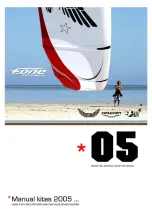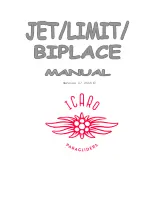
11
4. IN FLIGHT
We recommend that you read the certification test report.
The report contains all the necessary information on how the KOYOT 3 P
reacts during each of the tested manoeuvres.
It is important to point out that the appropriate response to each adverse
manoeuvre can vary from size to size; even within the same size at
maximum or minimum load the behaviour and reactions of the wing may
vary.
Having the knowledge that the testing house provides through the test
report is fundamental to learning how to deal with possible situations.
To become familiar with the manoeuvres described below, we
recommend practising within the auspices of a licensed training outfit.
4.1 FLYING IN TURBULENCE
The KOYOT 3 P has an excellent profile to deal with incidents; it is very
stable in all conditions and has a high degree of passive safety, even in
turbulent conditions.
All paragliders must be piloted for the prevailing conditions and the pilot
is the ultimate safety factor.
We recommend active flying in turbulent conditions, always taking
measures to maintain control of the wing, preventing it from collapsing
and restoring the speed required by the wing after each correction.
Do not correct the glider (braking) for too long in case this provokes a
stall. Whenever necessary, control a situation, react to it and then re-
establish the required speed.
4.2 POSSIBLE CONFIGURATIONS
To become familiar with the manoeuvres described below, we
recommend practising within the environment of a competent training
outfit. The pilot must adapt their use of the brakes depending on the
wing-loading and avoiding over-steering.
It is important to note that the type of reaction to a manoeuvre can vary
from one size of wing to another and even within the same size the
behaviour and reactions may be different depending on the wing-loading.
In the test report, you will find all the necessary information on how to
handle your new wing during each of the tested manoeuvres. Having this
information is crucial to know how to react during these manoeuvres in
real flight, so you can deal with these situations as safely as possible.
Asymmetric collapse
In spite of the KOYOT 3 P’s profile stability, strong turbulent air may
cause the wing to collapse asymmetrically in very strong turbulence,
especially if the pilot is unable to fly actively and prevent the collapse. In
this case the glider conveys a loss of pressure through the brake lines
and the harness. To prevent the collapse from happening, pull the brake
handle corresponding to the affected side of the wing. It will increase the
incidence of the wing (angle of attack). If the collapse does happen, the
KOYOT 3 P will not react violently, the turning tendency is gradual and
easily controlled. Weight-shift toward the open, flying side (the opposite
side of the collapse) to keep the wing flying straight, while applying light
brake pressure to that side if necessary. Normally, the collapsed side of
the wing should then recover and reopen by itself. If it does not, then pull
the brake handle on the collapsed side decisively and quickly all the way
(100%) down. You may have to repeat this pumping action to provoke
the re-opening of the deflated glider side. Do not over-brake or slow
down the flying side of the wing (control the turn). Once the collapsed
side is open make sure you return to the default flying speed.
Summary of Contents for KOYOT 3 P
Page 1: ...User s manual KOYOT 3 P...
Page 20: ...20 10 3 RISERS PLAN...
Page 21: ...21 10 4 SUSPENSION PLAN...
Page 26: ......











































